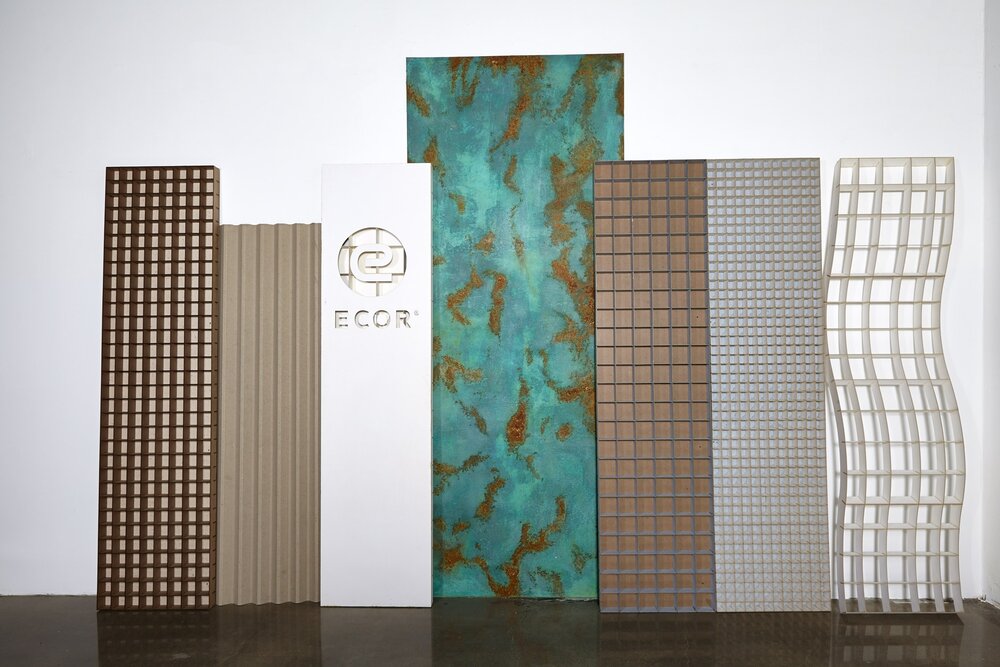The Future of Waste-based Materials, and Design for Disassembly with ECOR
By Purva Chawla (click here to read the original)
What sets ECOR apart from traditional materials like wood, MDF, and particleboard?
ECOR has begun disrupting the commodity material market for traditional building materials, by not only being lower cost but also providing greater strength, being VOC-free and emitting no toxic emissions. All this while being made from waste and being fully recyclable. ECOR technology is more than just a static building material or product–it provides a closed-loop process to convert waste resources into materials. At the same time, it address a range of unique global challenges, from failing recycling markets for paper and cardboard, as well as problematic agricultural waste being burned across the globe by farmers.
The ECOR innovation team has worked with hundreds of types of waste to create their ECOR Fiber-Alloys. These are made with different combinations of waste, ranging from basic paper and cardboard to spent brewers’ grains, denim lint, textiles, recycled labels, coffee grounds, oat and rice waste, and beyond. These unique Fiber-Alloys have enabled product manufacturers and consumer brands to analyze their waste output, and create business plans that leverage ECOR to convert their waste into materials and products which they can use throughout their supply chain, and/or can sell to their customers.
As designers and material specialists, the MaterialDriven team have watched ECOR materials being used over the past 3-4 years in a multitude of ways: architectural and interior environments, furniture–where it replaces materials like plywood and MDF–packaging, signage, exhibitions and temporary displays. The aesthetic USP for this material–whose un-laminated hues are natural browns, creams, and whites–is its ability to be detailed intricately using laser-cutting techniques.
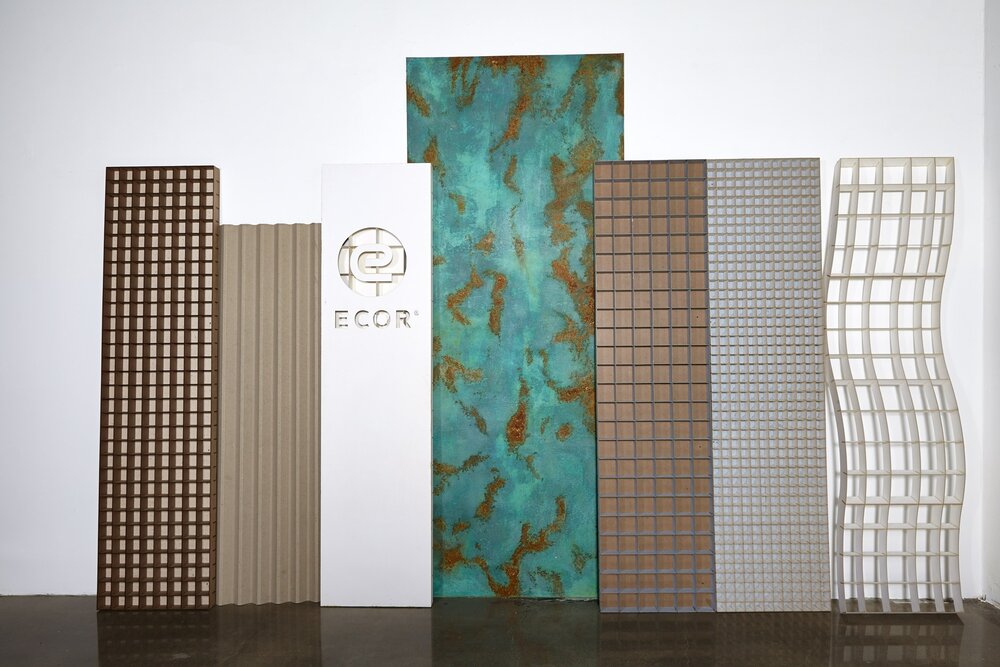 The versatile finishes, forms and detailing that can be created using ECOR’s Fiber Alloys
The versatile finishes, forms and detailing that can be created using ECOR’s Fiber Alloys
Recently, the company behind ECOR, Noble Environmental Technologies, took another giant leap in partnership with DSM and their NIAGA brand of recyclable glue. The partnership was set out to rethink the way that building materials are laminated, by providing a product that can “click and un-click”, using microwave frequency to separate panels from veneers– so that they can be easily disassembled and recycled. To understand just how significant this is, we only have to look at the scale of waste and pollution that occurs through non-recyclable building materials, particularly in the furniture and building industries, This is due to the glueing of materials that cannot be separated for recycling. We are excited to witness this strategic partnership between DSM-Niaga and ECOR, and the opportunity this combined effort has to disrupt not only the furniture sector but many more – by providing beautiful, low-cost, sustainable solutions for everything from furniture and cabinetry, to ceilings, floors and walls.
This move also opens up greater aesthetic possibilities for sustainably-minded designers. Previously, laminated versions of ECOR functioned like traditional materials, but now it is quick and easy to separate the veneer from ECOR panels, providing designers limitless design considerations–from using raw brown or white boards to unlimited veneered designs. Now, designers have an economical solution which they can integrate into projects–a product that is biodegradable, fully recyclable, VOC-free, and totally guilt-free.
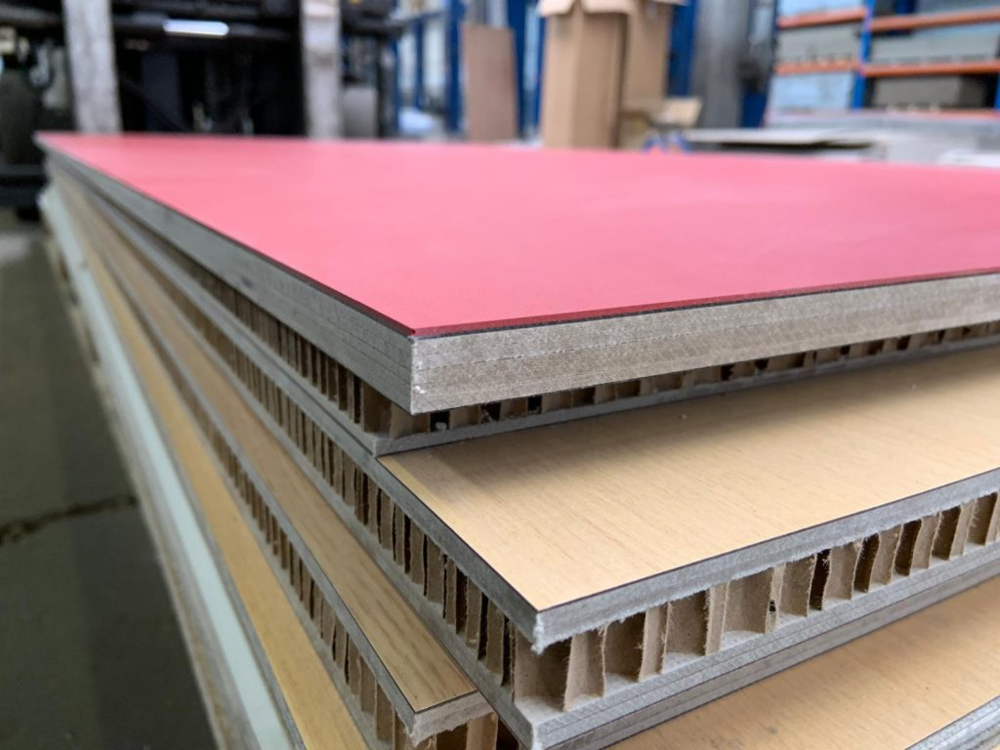 The Niaga ECOR Panel with laminated surfaces which can be recycled through the easy removal of the veneer
The Niaga ECOR Panel with laminated surfaces which can be recycled through the easy removal of the veneer
The Bigger Picture
Before diving into the specifics of the material and its newest, most evolved avatar, it is worth pausing and considering why and with what intention ECOR was invented. Even before the concept of the Circular Economy took hold globally, and gathered momentum, the entity behind ECOR was keen to address the idea of waste, and what, to them was the obvious convergence of the waste and material industries.
Rather than falling into the linear role of supplying materials just to end-users or distributors, the company has opted to work in close collaboration with both market-leading manufacturers for building products and furniture, as well as with sustainable consumer product brands. This has allowed them to create scalable and licensable solutions that not only substantially reduce environmental impact, but also create new revenue opportunities and reduce a range of costs within the supply chain. These partners often start out by working with ECOR’s R&D team to create “small batch” ECOR panels made from their waste and then advance to using these materials in prototypes of the products they sell, and/or the materials they use. This uniquely enables enterprises to step into engagement within the circular economy, and develop the foundation for a business case that can scale rapidly and smoothly into their existing business models and supply chains.
Recently, we were pleased to hear how Heineken has engaged in pilot projects to use ECOR made with grains leftover from their beer-making process. The projects led to the design of a range of interior décor, furniture, and fixture products within their new brewery in Mexico. Another great example is how Schiphol Airport, in The Netherlands, developed its own Schiphol ECOR Fiber Alloy, which was used throughout the airport for construction and kiosks. The Fiber-Alloy, (for which there is a larger rollout plan across interior design and construction), integrated the cellulose fiber waste from Tetra Pak juice containers at the airport, as well as harvested Miscanthus (a large razor-sharp plant grown around the airport to protect against bird strikes).
The company offers smart cities, sustainable brands, and manufacturers a turn-key or licensable solution–to leverage ECOR factories to recoup value from their waste streams, by converting it into their own ECOR-based materials and products. The process begins by evaluating their waste streams, followed by extensive lab-testing, and assessment of the prototyped materials for long-term and short term usage, and then finally leads to the creation of bespoke, commercially scalable ECOR panels for clients.
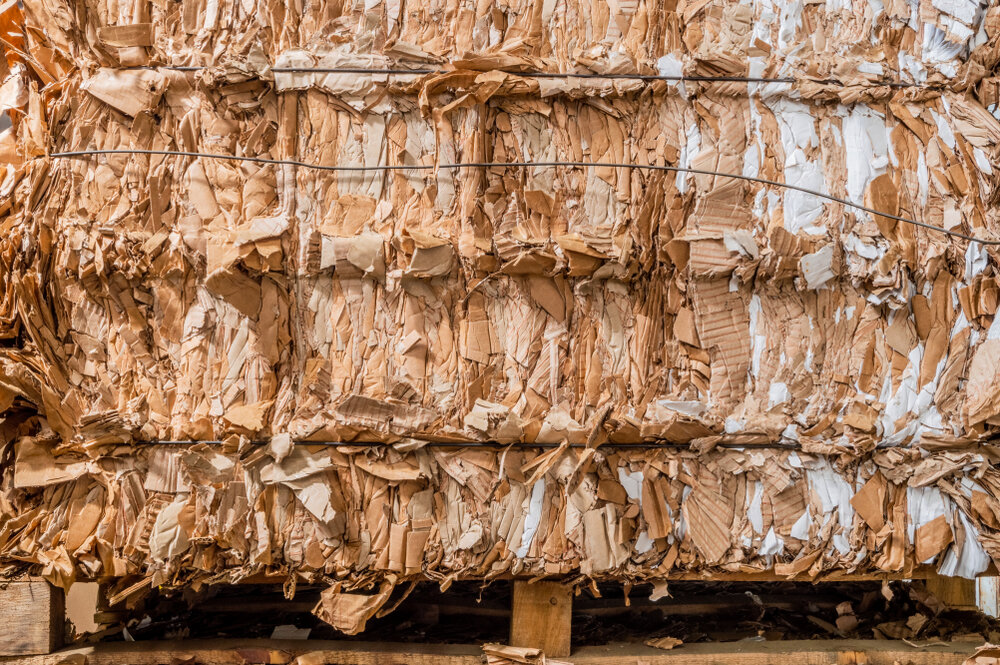 Paper and cardboard waste are among the many waste streams transformed by ECOR into their Fiber Alloys. These include spent brewers’ grains, denim lint, textiles, recycled labels, coffee grounds, oat and rice waste and more.
Paper and cardboard waste are among the many waste streams transformed by ECOR into their Fiber Alloys. These include spent brewers’ grains, denim lint, textiles, recycled labels, coffee grounds, oat and rice waste and more.
While a stock of standard ECOR materials is always available to designers, this small-batch service has so far resulted in panels molded with waste that includes coffee grounds, spent beer hops, denim lint, synthetic leather used to make shoes, textiles, coconut husks, lavender, old books, Tetra Pak and even major league baseball bats and balls. The producers of these waste streams are often mammoth-sized organizations with equally large global footprints, who can easily use these materials in their operations at no additional expense.
A transplantable, local solution for Global challenges
The fact that both the recipe and production of ECOR are dynamic– able to embrace a variety of waste streams–make it inherently transplantable. Add to that the fact that ECOR provides substantial cost savings to the generator of the waste. ECOR’s business model forecasts setting up many localized production facilities, at the site of regional or project-specific waste streams, where panels can be utilized for use within those operations or communities. This also ties in with the company’s intention that materials should not be transported over long distances, considering the challenges of large carbon footprints and resource scarcity we face today.
This is particularly relevant for the global housing deficit, which is expected to impact 1.6 billion people by 2025. Lightweight and local waste-based ECOR materials can respond to our need for affordable and efficient housing, and assist in the sustainable construction of new homes. This not only provides for local employment and low-cost materials, it eliminates costly waste, and paves the way for the natural development of a vibrant cottage fabrication industry, The company’s partners are currently exploring Design-Build solutions centered around the ECOR technology to enable the redevelopment of slums in Mumbai, Riyadh, and cities throughout Asia and Africa.
In India, the company has joined a syndicate, which includes DSM, Unilever, and IKEA, to convert agricultural rice waste into materials (including ECOR) to be used by these partners for materials throughout their supply chain, including furniture. The health impact (through pollution) and the resulting expense of burning agricultural waste are immense in India, with Rice being one of the most significant volumes of crops burned each year. The burning of crops in India is estimated to kill 1 million people a year, while farmers have little or nothing to gain financially from this path to disposing of their crop waste. Farmers will now be incentivized to instead sell their waste, for conversion into materials. These materials can be used for building products for new homes and buildings in India, and ultimately for furniture sold by IKEA or other local furniture manufacturers looking for low-cost, high performing materials.
 A syndicate consisting of ECOR, DSM, Unilever, and IKEA, will address the challenge of burning rice crop waste by buying and transforming this waste into new materials in India.
A syndicate consisting of ECOR, DSM, Unilever, and IKEA, will address the challenge of burning rice crop waste by buying and transforming this waste into new materials in India.
On the other end of the spectrum, is the sheer volume of construction needed and waste generated for significant global events such as the Olympics and trade expos. Housing stock, exhibition and spectator structures, and facilities must be rapidly created ahead of these, and at the same time, the period immediately following such events sees vast deconstruction, discarding of materials and valuable resources, and their direction to landfill.
A recent partnership struck between Saga City, Morodomi Furniture Promotion Association in Japan and ECOR intends to change this norm. In anticipation of the Tokyo 2020 Olympics and the 2025 World Expo in Osaka, the companies have come together (bringing with them their waste streams and technology respectively) to co-create circular furniture based on unused fibre-rich residue streams. The partnership has been set up to create a bespoke panel from unused resources in Saga City. The material will serve as a furniture and interior design material for temporary facilities at the Tokyo Olympics 2020 and will emerge from a pilot plant set up to produce the panel in Saga. This summer, the first prototypes of such circular furniture were revealed, crafted with panels by ECOR, Japanese patented cypress veneer by Nakamura, and based on chair and table designs by Hirata and Legnatec respectively.
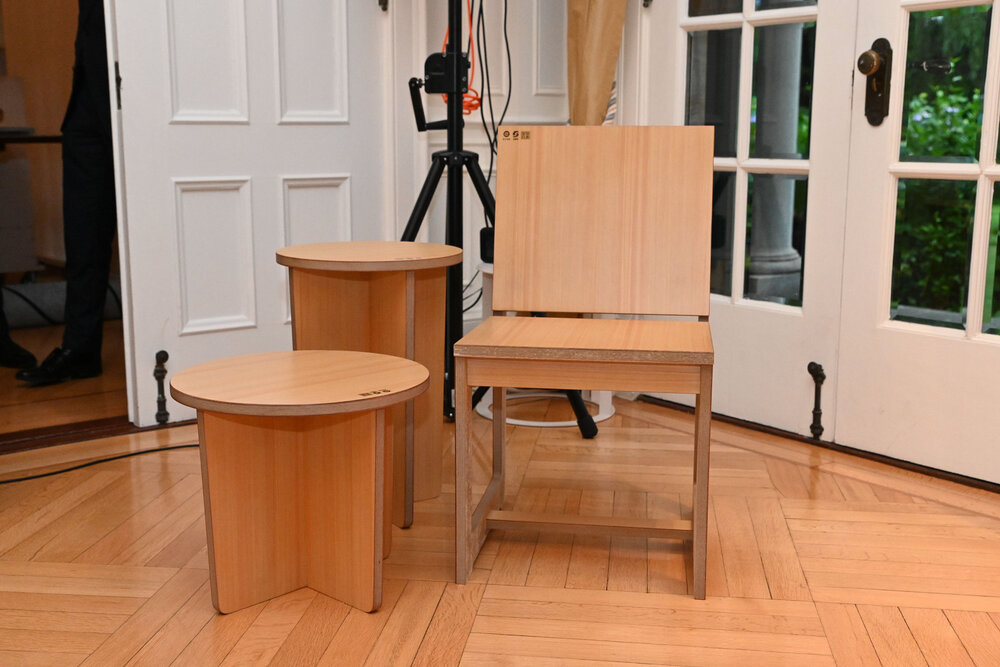 ECOR Panels and circular furniture created for the Tokyo 2020 Olympics and the 2025 World Expo in Osaka, through a partnership between Saga City, Morodomi Furniture Promotion Association in Japan and ECOR.
ECOR Panels and circular furniture created for the Tokyo 2020 Olympics and the 2025 World Expo in Osaka, through a partnership between Saga City, Morodomi Furniture Promotion Association in Japan and ECOR.  The summer 2019 launch of ECOR Panels and circular furniture created for the Tokyo 2020 Olympics and the 2025 World Expo in Osaka, through a partnership between Saga City, Morodomi Furniture Promotion Association in Japan and ECOR.
The summer 2019 launch of ECOR Panels and circular furniture created for the Tokyo 2020 Olympics and the 2025 World Expo in Osaka, through a partnership between Saga City, Morodomi Furniture Promotion Association in Japan and ECOR.
The Business Case
The incentive for using ECOR, in addition to its valuable end of life characteristics and its toxin-free bio-based nature, is the strong business case it presents. The sheet material is affordable and comparable to traditional wood-based counterparts (plywood, particleboard, MDF) on the one hand, and on the other, companies can use or sell their waste streams to create ECOR materials and see sizable economic and socially accretive returns. With countries such as China banning the import of waste from around the world, ECOR enables cities, brands and waste management enterprises to instead leverage their waste streams by converting then into higher value materials and products—sometimes at rates more attractive than what they were offered from China prior to the ban.
Finally, the cost (both financial and environmental) of disposing used, low-value materials and products is becoming more and more crucial for the bottom line of companies. The cost of disposal is spiraling upwards and faster, and in the Northeast of the US, there is now only eight years of available landfill space left. The solution is to keep raw material in the use cycle and out of landfill or incineration, where it can be recycled, recovered, and reprocessed so that it can serve for many life cycles.
Niaga ECOR Panel (NEP)–Glue Like a Screw
The newly launched Niaga ECOR Panel (NEP) is the result of a strategic partnership between ECOR and DSM-Niaga. At the end of 2017, DSM and their Niaga brand announced a collaborative engagement with ECOR focused on commercializing a technology that integrated their sustainable Niaga glue and ECOR materials. The aim was to provide furniture makers with an alternative to MDF and particleboard–laminated and un-laminated–that would be made from recycled materials, free of VOCs, and which can be fully recycled.
The NEP was developed to respond to the immense wastage in the furniture industry today–the US alone landfills 8.5 million tons of furniture annually, and this number spikes to 50 million tons globally (equalling $2.0 billion dollars in avoidable expense), in addition to fostering the trend of Conscious Consumerism. NEP capitalizes on the individual properties of ECOR’s materials, and Niaga’s adhesive technology. Niaga’s adhesive (toxin-free) separates on-demand–indeed this ‘glue behaves like a screw,’ allowing for the decoupling of different materials (such as veneers from a substrate, in the case of the NEP) in a product at the end of its life.
Representing a growing momentum towards Design for Disassembly, the NEP offers a path forward for conscious designers, manufacturers, and consumers. Not only does the NEP make the job of recyclers easier and more profitable, and contributes to lowering global waste, it allows us to reconcile with current rapid consumerism, by offering a better end of life and indeed many lives for the same materials, even if products are short-lived. Beyond this, the panel is another step in tackling resource scarcity.
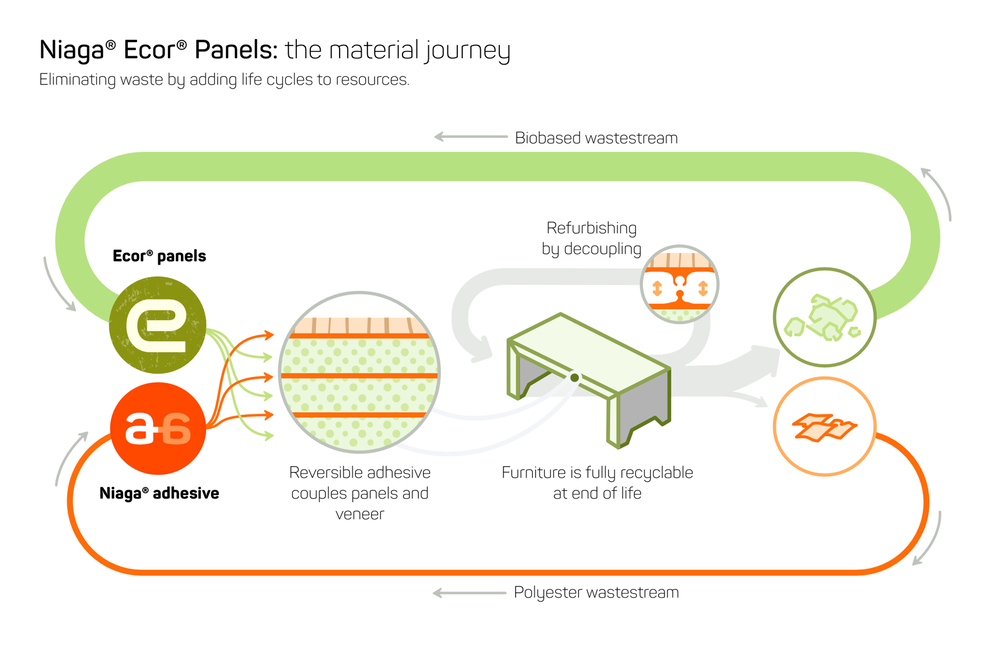
Design Potential and Trends
The NIAGA ECOR panels outperform materials like MDF and particleboard from a strength to performance perspective and are designed to be less expensive, especially for customers that issue long-term purchase contracts with the companies. The material was recently brought to market, with the first production batch sold out to 4 Dutch furniture manufacturers. These designers have used NEPs to create a range of furniture products for the home, office, children’s nurseries, and schools.
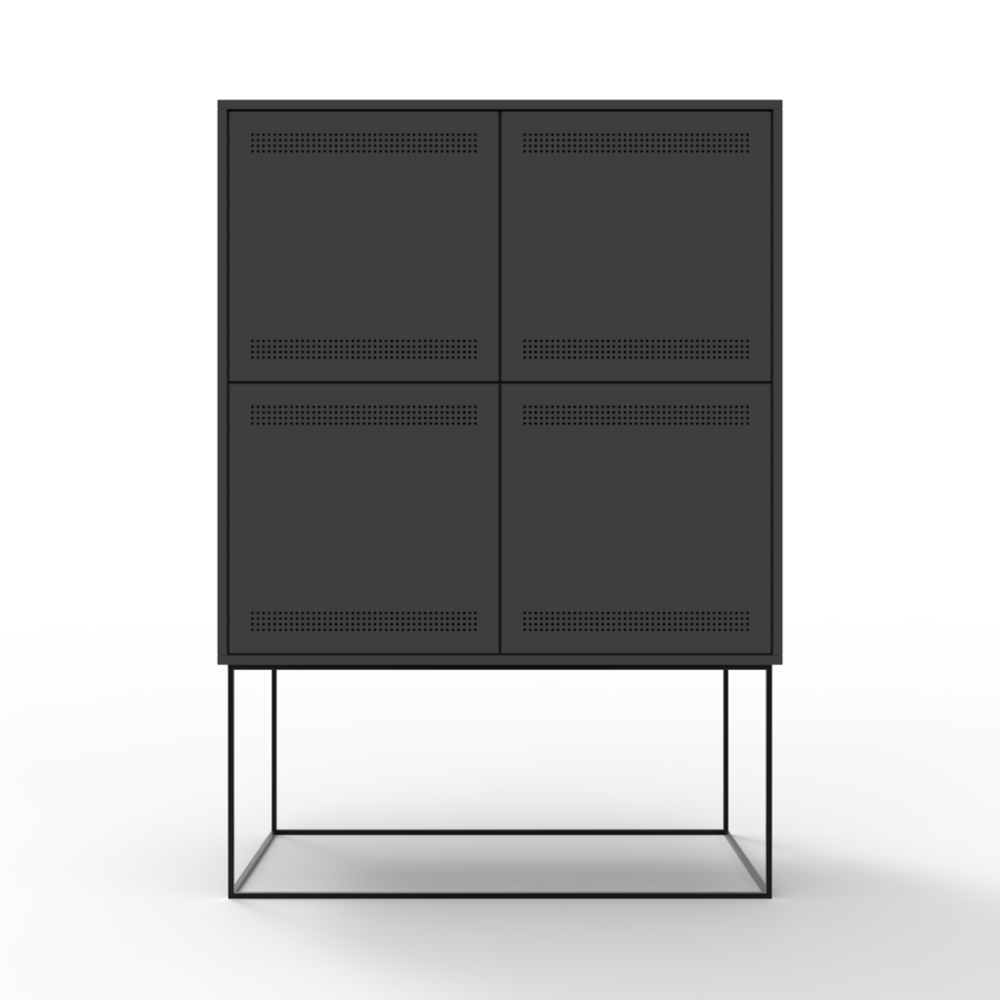
At the same time, these panels were also delivered to the global ECOR & Niaga Makers Community, a growing group of professional designers, scientists, and craftsmen, to test the product and explore its potential creatively. Among the early adopters and users of the NEP has been Amsterdam-based Pim Dekkers Studio–a practice hinged on circular and low-carbon design. He has used NEPs to craft his sleek ‘Paper Collection’–a set of charcoal and white cabinets, which can be separated into their component materials at the end of life and these can be harvested and recycled further.
[embedded content]
About DSM Niaga
Netherlands-based Niaga works with a non-negotiable design philosophy to make products healthier and fully recyclable, a perfect match for the ethos of that ECOR has. All products redesigned by the company are fully recyclable back into the same product. The first product Niaga took on to redesign was carpet, inspired by its contribution to local waste problems. Here, a carpet created with only or two materials meets all performance demands, and when it is no longer in use, a recycler can “un-click” the adhesive to harvest two pure material streams.
Beyond carpet and the NEP, DSM-Niaga has applied their design philosophy to product categories such as mattresses. Mattresses designed by Niaga proved the health benefits of design for circularity. Their modular design with reversible connections also allows for easy maintenance of the mattress for quality or hygiene reasons, especially in hospitality settings.
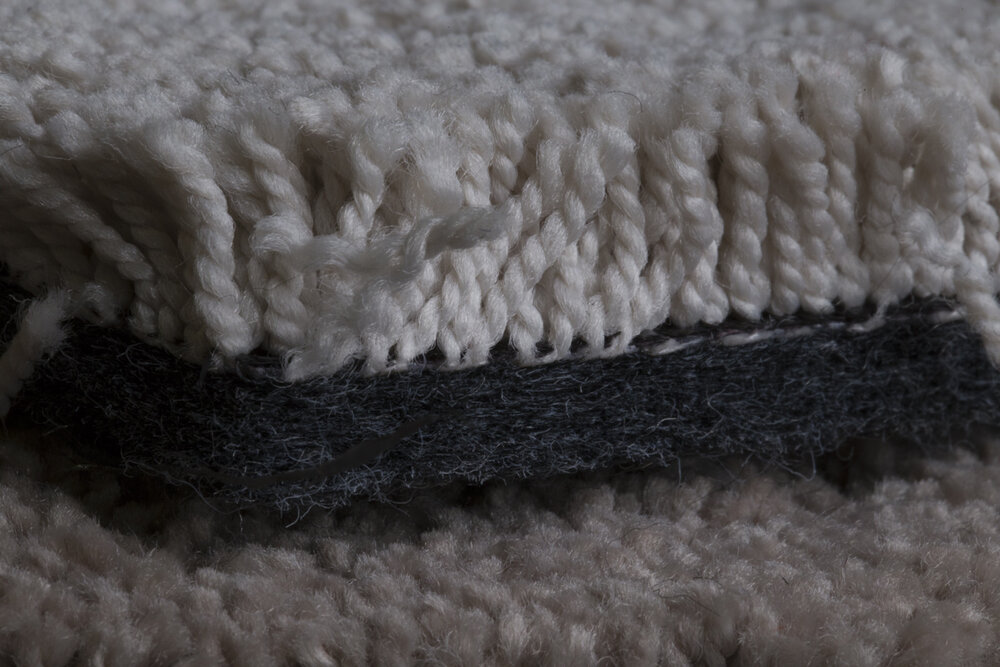 Niaga Carpet with reversible adhesive
Niaga Carpet with reversible adhesive

